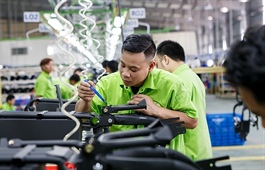Short food supply chain model set for success in Viet Nam
Short food supply chain model set for success in Viet Nam
A new research by the Konrad Adenauer Stiftung and Institute for European Studies shows that the short food supply chain (SFSC) model, although newly implemented in Viet Nam, has had promising results.

The research was published at a recent seminar, with attendance from Vu Thi Thu Phuong, program director, KAS Viet Nam; Dang Minh Duc, deputy director of the Institute for European Studies; Nguyen An Ha, former director of the Institute for European Studies; as well as representatives from the Ministry of Commerce, the Viet Nam Farmer's Union, universities and businesses.
Short food supply chain (SFSC), is a term for a system which involves a direct relationship between the producer and the consumer, including but not limited to in-farm stores and farmers' markets.
SFSC is considered a more sustainable supply chain for agricultural products. Some examples of successful SFSCs can be seen in Europe such as Italy's Campana Amica with more than 10,000 direct stores, and France's Pays de la Loire and Le Gout d'Ici.
SFSC shortens the time and decreases intermediaries between producers and consumers, so that consumers can benefit from better and cheaper products, and farmers can better diversify and aim towards greener production and a more stable revenue model.
Governments can also benefit from SFSCs as a better tool in developing agriculture, and creating sustainable livelihoods for the farmers.
"SFSCs, however, have a whole new definition in Viet Nam and have not garnered enough attention," said Dang Minh Duc, deputy director of the Institute for European Studies.
Viet Nam currently has no policies that encourage the development of a sustainable SFSC. Also, as SFSCs focus on the relationship between farmers and businesses, such relationships in Viet Nam are still weak.
Farmers and businesses are limited in accessing knowledge involving safety protocols and quality assurance, therefore cannot be eligible for EU standards.
Agriculture supply chains in Viet Nam are defined through government decrees such as the "National Target Program On Building A New Countryside During 2016-2020," which gave farmers better working conditions and better distribution of agricultural products. However, these policies are not designed specifically for the development of SFSCs, nor do they encourage them.
The fact that SFSCs are mostly ignored is incomprehensible, since Viet Nam has the necessary resources, both naturally and artificially, to further progress the agriculture sector, as research groups have concluded.
Such research was conducted in Son La Province. Son La is well-known for its variety of fruit, such as mangos, oranges, tangerines and plums. These fruits are planted in great numbers across the province, with 181 production unit codes (PUCs) eligible for export, totalling 4,670 hectares.
A total of 130 PUCs of longan fruits, mangos, bananas and papayas will be exported to China, whereas 51 PUCs of longan fruits, mangos, plums and avocados are aimed at US and Australian markets.
Although initial successes were recorded, such as with Son La's passion fruits passing EVFTA requirements and being available in French supermarkets, other fruit products are not so lucky.
Most of the northern province's fruits are only eligible for VietGAP standards, but not GlobalGAP - the quality standard for European agricultural exports.
"Twenty-one per cent of farmers admitted that they used pesticides, but this number is on the decrease, as farmers are looking into alternatives such as organic fertilisers," said Dr. Bui Viet Hung of the IES.
Many of the seminar's private sector delegates share an eagerness to apply Son La's model to their businesses. Researchers and agricultural entrepreneurs share the consensus that government agencies should take a look at their policies, especially in developing SFSCs with the goal of eligibility for the European Union's rigorous quality standards.


























